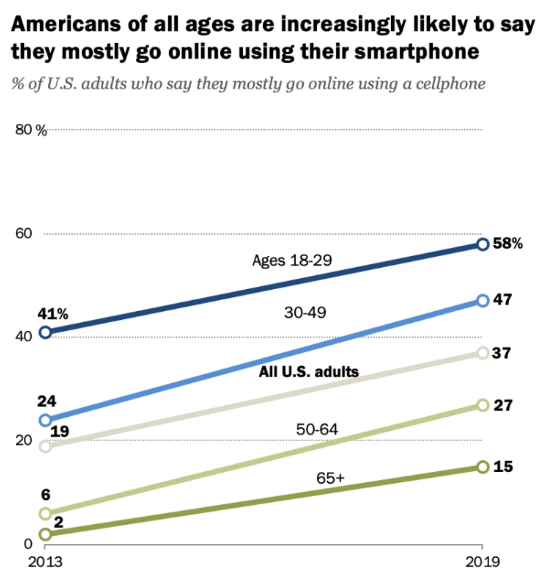Mobile dampening desire for fixed broadband – Pew ResearchMobile dampening desire for fixed broadband – Pew Research
The Pew Research Centre has unveiled research suggesting home broadband products are becoming less attractive as mobile wins the digital hearts and minds of the US.
June 14, 2019

The Pew Research Centre has unveiled research suggesting home broadband products are becoming less attractive as mobile wins the digital hearts and minds of the US.
Although the laws of physics suggest fixed connectivity, at least when you have a fibre connection, will always be the best gateway to the digital world, progress in the mobile world seems to be dampening consumer enthusiasm.
According to the research, 37% of US adults say they mostly use a smartphone when accessing the internet. For those aged between 18 and 29, 58% of the respondents to the survey suggest mobile devices are the primary gateway to the internet. The numbers are less striking as the ages increase, though all of the demographics demonstrated an increase. Mobile is increasing becoming the primary access point to the digital world.

Although this will be encouraging to MNOs, those telcos who offer fixed products, or a converged service, might be slightly worried.
27% of the respondents to the survey claim they do not subscribe to a home broadband service, with more and more suggesting the reason for this is do to mobile. If they can do everything they need to do through a mobile tariff, why would they double down and make their connected experience more expensive by paying for a home broadband service as well?
45% of those who do not have a home broadband service suggest it is because of mobile, this is a notable increase from the 27% who cited this reason in 2015. 80% of this segment have also said they do not have any interest in purchasing a home broadband service in the future. 17% of US consumers now only have a mobile broadband subscription, increasing from 8% in 2013.
Although some might simply shrug at these data points, what it worth noting is that the smartphone-only users are generally from the lower-income demographics. If there was more of an even spread across all demographics, this would be an interesting trend worth keeping an eye-on, however as it is largely limited to low-income families this is evidence of the digital divide in action.
Interestingly enough, these trends can also be applied to the various different education levels. 26% of adults who have a high school education or less are smartphone only internet users, a number which drops to 16% with some college experience and only 4% of graduates feature in this category.
Although there is a drive from the FCC and government to improve accessibility and affordability of home broadband services in the US to counter the digital divide, research like this suggests the initiatives are not have the desired impact.
About the Author
You May Also Like










.png?width=300&auto=webp&quality=80&disable=upscale)


_1.jpg?width=300&auto=webp&quality=80&disable=upscale)